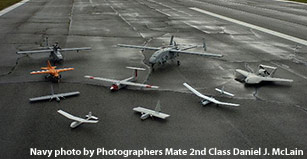 The FAA has announced a proposed rule governing the use of commercial small unmanned aircraft systems (UAS) that would address many of AOPA's concerns, including setting certification requirements for operators and requiring see-and-avoid capabilities. The rule affects UAS weighing 55 pounds or less that are flown for non-recreational purposes.
The FAA has announced a proposed rule governing the use of commercial small unmanned aircraft systems (UAS) that would address many of AOPA's concerns, including setting certification requirements for operators and requiring see-and-avoid capabilities. The rule affects UAS weighing 55 pounds or less that are flown for non-recreational purposes.
Transportation Secretary Anthony Foxx and FAA Administrator Michael Huerta announced details of the proposed rule during an unusual Sunday news conference on Feb. 15. Under the notice of proposed rulemaking (NPRM), small UAS would be required to “see and avoid” other aircraft, giving right of way to manned aircraft.
They also would be limited to daylight, line-of-sight operations with a least 3 statute miles visibility at speeds of less than 100 mph and altitudes below 500 feet. The UAS would not be allowed to operate over people, except those involved in the flight. They would be required to remain outside of Class A airspace and at least 500 feet below clouds and 2,000 feet from them horizontally. Operations in Class B, C, and D airspace, as well as within the lateral boundaries of the surface area of Class E airspace, can be allowed with prior permission from air traffic control.
The NPRM also sets certification requirements for small UAS operators, requiring them to be at least 17 years of age, pass an FAA-administered knowledge test every two years, and obtain an FAA-issued UAS Operator Certificate with a small UAS rating.
While the FAA will not require the aircraft themselves to be certified, it will require them to obtain an FAA registration and display an N-number. Operators must also conduct preflight safety inspections before each flight.
“Safety is our biggest concern when it comes to integrating unmanned aircraft into the airspace system,” said AOPA President Mark Baker. “Clear guidance for UAS operations is needed to protect pilots and passengers. We’re pleased that the FAA is moving the rulemaking process forward, but this really can’t happen fast enough.”
Privacy issues also have been a concern when it comes to small UAS operations, but the FAA’s NPRM does not address those issues. Instead, the FAA has said the National Telecommunications and Information Administration (NTIA) will engage with the FAA and stakeholders to address privacy issues.
In the meantime, the White House issued a presidential memorandum dealing with drone privacy issues shortly before the FAA’s Feb. 15 announcement. The memo requires federal agencies to make their policies and procedures consistent with limits on data collection and use as well as the retention and dissemination of information collected by drones. It also gives the NTIA and Commerce Department 90 days to create a “framework for privacy, accountability and transparency.”
In announcing the new rules for small commercial drones, the FAA said it would seek input on whether to create a subset of rules for so-called “microlight” UAS weighing 4.4 pounds or less. The FAA suggested those aircraft might not require a UAS operator certificate but could be restricted to daytime line-of-site operations at altitudes of 400 feet or lower in Class G airspace. Those requirements are not part of the current proposed rule.
The agency is also seeking input on how the agency can further leverage the UAS test site program as well as plans for a UAS Center of Excellence designed to spur innovation.
The publication of the NPRM opens the way for the public to review and comment on the proposal, and AOPA will file formal comments in advance of the deadline set for 60 days from the date of publication in the Federal Register.
AOPA has long expressed concerns about safely integrating unmanned aircraft into the National Airspace System, insisting that commercial UAS be flown by an FAA-approved pilot or operator, have see-and-avoid capabilities, and be flown in compliance with current operating rules and airspace requirements.
In December 2014, Baker asked the House Aviation Subcommittee to reinforce the need for the FAA to expedite the rule governing commercial UAS operations and to address the reckless and careless operation of recreational UAS. In 2014, the FAA received nearly 200 pilot reports describing encounters with unmanned aircraft.
While the NPRM does not address recreational UAS operations, AOPA has asked the FAA to issue clear and definitive guidance for recreational operators, encourage manufacturers to include information on FAA guidance in their packaging materials, work with AOPA and remote control aircraft groups to conduct educational outreach, and publish guidance to help pilots file timely reports of reckless UAS operations.



